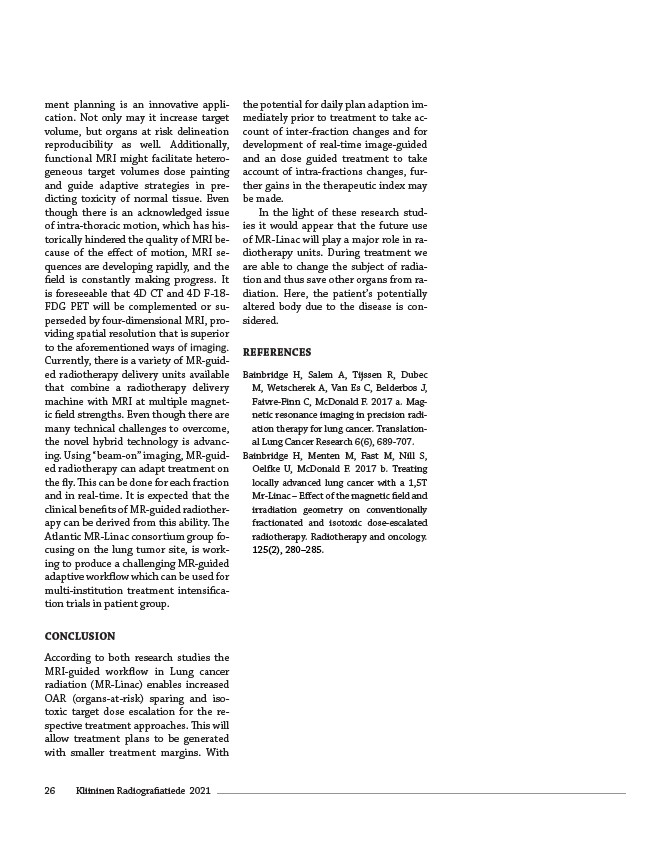
ment planning is an innovative appli-cation.
Not only may it increase target
volume, but organs at risk delineation
reproducibility as well. Additionally,
functional MRI might facilitate hetero-geneous
target volumes dose painting
and guide adaptive strategies in pre-dicting
toxicity of normal tissue. Even
though there is an acknowledged issue
of intra-thoracic motion, which has his-torically
hindered the quality of MRI be-cause
of the effect of motion, MRI se-quences
are developing rapidly, and the
field is constantly making progress. It
is foreseeable that 4D CT and 4D F-18-
FDG PET will be complemented or su-perseded
by four-dimensional MRI, pro-viding
spatial resolution that is superior
to the aforementioned ways of imaging.
Currently, there is a variety of MR-guid-ed
radiotherapy delivery units available
that combine a radiotherapy delivery
machine with MRI at multiple magnet-ic
field strengths. Even though there are
many technical challenges to overcome,
the novel hybrid technology is advanc-ing.
Using “beam-on” imaging, MR-guid-ed
radiotherapy can adapt treatment on
the fly. This can be done for each fraction
and in real-time. It is expected that the
clinical benefits of MR-guided radiother-apy
can be derived from this ability. The
Atlantic MR-Linac consortium group fo-cusing
on the lung tumor site, is work-ing
to produce a challenging MR-guided
adaptive workflow which can be used for
multi-institution treatment intensifica-tion
trials in patient group.
CONCLUSION
According to both research studies the
MRI-guided workflow in Lung cancer
radiation (MR-Linac) enables increased
OAR (organs-at-risk) sparing and iso-toxic
target dose escalation for the re-spective
treatment approaches. This will
allow treatment plans to be generated
with smaller treatment margins. With
26 Kliininen Radiografiatiede 2021
the potential for daily plan adaption im-mediately
prior to treatment to take ac-count
of inter-fraction changes and for
development of real-time image-guided
and an dose guided treatment to take
account of intra-fractions changes, fur-ther
gains in the therapeutic index may
be made.
In the light of these research stud-ies
it would appear that the future use
of MR-Linac will play a major role in ra-diotherapy
units. During treatment we
are able to change the subject of radia-tion
and thus save other organs from ra-diation.
Here, the patient’s potentially
altered body due to the disease is con-sidered.
REFERENCES
Bainbridge H, Salem A, Tijssen R, Dubec
M, Wetscherek A, Van Es C, Belderbos J,
Faivre-Finn C, McDonald F. 2017 a. Mag-netic
resonance imaging in precision radi-ation
therapy for lung cancer. Translation-al
Lung Cancer Research 6(6), 689-707.
Bainbridge H, Menten M, Fast M, Nill S,
Oelfke U, McDonald F. 2017 b. Treating
locally advanced lung cancer with a 1,5T
Mr-Linac – Effect of the magnetic field and
irradiation geometry on conventionally
fractionated and isotoxic dose-escalated
radiotherapy. Radiotherapy and oncology.
125(2), 280–285.